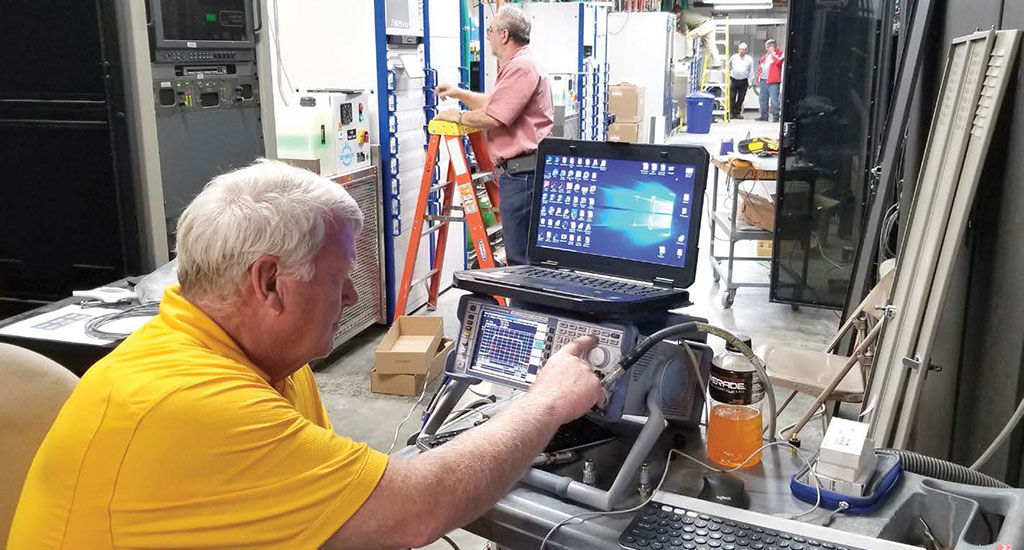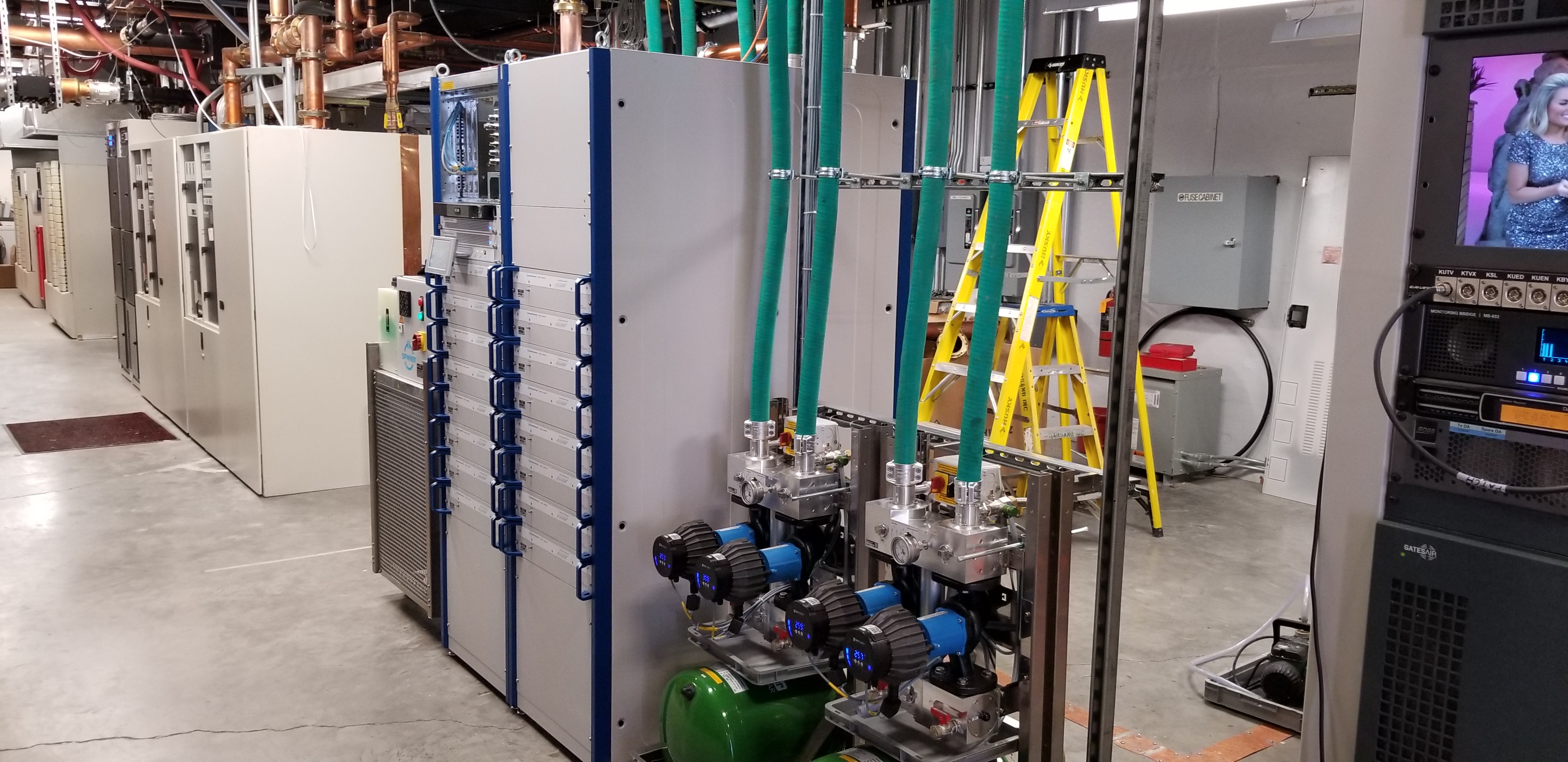DTV Utah Completes Successful Repack
SALT LAKE CITY— In March 2017, DTV Utah began plans on repacking six of its eight DTV Utah Stations that were required to change frequencies as a result of the spectrum auction. DTV Utah, LLC is a television transmitter site located in the Oquirrh Mountains above Salt Lake City, Utah, and was the location of a complex, channel repack project involving nine UHF television stations, with eight of the transmitters combined into a community antenna.
DTV Utah, LLC was formed in 1998 as a nonprofit corporation that owns and operates the community television facility. Greg James of Bonneville International originated the concept of a community site for the new digital service.

“The discussion revolved around the problem created for viewers, if stations were dispersed over a wide geographic area,” James said. “As I thought about multipath in the mountainous area we live in, it made a lot of sense to broadcast from a single location.”
[Read: Eight TV Stations On One Stick Ponder Repack]
Other benefits of co-locating the markets transmitters include economies of scale and reduction of intermodulation interference.
The television stations currently in the DTV Utah group include:
• KSL (Bonneville International)
• KUTV and KJZZ (Sinclair Broadcasting)
• KTVX and KUCW (Nexstar)
• KUED and KUEN (University of Utah)
• KBYU (Brigham Young University)
Get the TV Tech Newsletter
The professional video industry's #1 source for news, trends and product and tech information. Sign up below.
The DTV Utah site is located 9,000 feet above sea level, with limited access via a 10-mile single-lane dirt road, limited space for construction and a limited seasonal construction window of four months due to weather conditions and road access.
The original DTV Utah site consisted of two four-channel Dielectric combiners, connected to either the main Kathrein antenna, or to an auxiliary antenna through a complex waveguide switching network with five modes of operation. In addition, all eight stations could be combined together and routed to any of the three antennas.
COMPLICATIONS ARISE
It was soon discovered that the original WR 1500 waveguide was not going to pass the new frequencies. The existing Kathrein community antenna also required evaluation to determine if it would perform under the new parameters. The repack design was also complicated by the frequencies that were assigned. Channel 34 (KUTV) and Channel 36 (KUEN) did not require change, but as fate would have it, Channel 35 was assigned to KUCW, creating three adjacent channels and potential intermodulation issues.
Other challenges included transmitter cooling at the thin air of 9,000 feet, transmission line performance, and the requirement to stay on the air while creating a seamless transition to the new channels.
The repack design included a patch panel that provided a path for the N+1 transmitter to replace any of the eight transmitters at the input of the combiner.
Marsand Inc.'s Matthew A. Sanderford, Jr. PE and David Sanderford installed the transmitters while Legacy Electric of Salt Lake City did the electrical work. Tower and antenna work was performed by GTI, America and Burk Technology designed the control system. Climate Control (CCI) handled HVAC.
TRANSMITTERS AND COMBINER
Each station decided on the make and model of the eight new transmitters; Five Rohde and Schwarz THU9evo transmitters and three Gates Air Maxiva UXLT transmitters, including the N+1 transmitter were installed along with one Dielectric combiner and six Dielectric WR1800 waveguide switches for nine different combiner/antenna/test load modes.

Each station purchased their own transmitters based on their own evaluations. “Given the complexity of the project, I suggested one installer for all of the transmitters,” James said. “It would have been a nightmare to schedule different crews on each transmitter. The same was true for electrical, HVAC, and so on.”
The new Dielectric, dual four-port combiner was installed in a very tight 20 x 17 x 9-foot space.
How do you keep your station on the air, while removing your old transmitter and installing the new one? All eight stations were operated at lower power into the auxiliary community antenna through the period of construction and transition. The GatesAir N+1 transmitter was delivered with broadband power amplifiers. As the N+1 was placed on the air, the old transmitter was decommissioned and the new transmitter installed, tuned to the original frequency and tested through the combiner/mask filter to a load.
SEVEN-DAY PROCESS
Each transmitter switch-out took about seven days and the process of bringing each transmitter on line was complex. First, engineers had to run transmitter power at the level that delivered the power calculated to meet ERP requirements of the station, when measured at the dummy load at the output of the combiner. They then had to measure the input power to the combiner hybrid; measure transmitter power out, and calibrate that as 100 percent power. This had to be repeated for each of the four profiles in each transmitter.
A spectrum analyzer was used to perform a power-band measurement on the four combined channels to verify spectrum compliance. As a final step, each station’s reflected power spectrum was recorded to determine a baseline for monthly performance tests.
COMMUNITY ANTENNA REBUILD
The original Kathrein antenna (two Kathrein eight tier by three bay antenna systems—48 panels total), was selected because of the extensive use of the antenna in the Swiss Alps. The temperature extremes at the DTV Utah site are very similar to the Alps, with a thermal swing of over 100 degrees winter to summer (-18F to +85F) Grundy Telecommunications Inc., America, was asked to review the existing Kathrein community antenna system and Kathrein Antenna Works sent an engineer who helped in the evaluation. After band sweeping and physical inspection, engineers determined that the existing antenna system would not perform well for the repack system.
The original tower was custom-built to support the Kathrein 70 x 6-foot radome cylinder. DTV Utah considered replacing the antenna with a different make and model, but structural modifications to the tower would have made replacement cost prohibitive. Kathrein was asked to develop a replacement antenna system … since the radome cylinder supported the antenna, it seemed possible to remove the old antenna system and replace it with a new one.
The next step was demolition and rebuild of the antenna system. Grundy removed main power dividers, cabling harnesses, tier power dividers and panel mounts—some three tons of it—in less than a week. The crew then began installing the new antenna, and six weeks later the rebuilt antenna system was ready for testing.
Katherine field engineers did a proof-of-performance; results were good with the lower antenna showing 28 dB return loss on the lower antenna and 30 dB return loss on the upper; this equates to a VSWR on the upper in the 1.08:1 and the lower antenna at 1.1:1.
OTHER SYSTEMS
For the Burk remote control system, equipment was specified and truth tables developed for interlocking. In some of the modes, reduced power is required. The Burk unit can talk to the transmitters based on the selected mode and ensure that their power levels are correct. If not, the it will shut the offending transmitter down and alert the operator.
Transmission line arc protection was provided by South-Tek Systems, N2-GEN, nitrogen generators.
RESULTS
After a month and a half of construction, all transmitters were installed and operating on the old frequencies. Once all transmitters were installed, commissioned and tested, the new transmitters were retuned to the new frequencies and switched into the refurbished community antenna.
Mario Hieb is a professional broadcast engineer based in the Salt Lake City area.
For all the latest news and insight on the repack, visit our repack silo.
